Movie Review By: SFAM
Year: 2005
Directed by: Clive Cohen
Written by: Clive Cohen
IMDB Reference
Degree of Cyberpunk Visuals: Low
Correlation to Cyberpunk Themes: Low
Rating: 2 out of 10

Overview: So you’re really into big breasted chicks getting gored by robots, ey? If this is the variety of fetish porn you’ve been hankerin for, then Exterminator City is probably an automatic buy decision. One word of caution - you aren’t really getting robots, you’re getting a cheaper version of the old Muppet’s skit, Pigs in Space-style robot puppets. Basically you get shiny plastic robot heads (are these supposed to be metal?) with movable jaws, mounted on dressed clothing racks. A real person wearing gloves is shemping the hand movements, while the lower jaw goes up and down to mimic talking (robots MUST have working jaws, right - I mean who would believe that robots would have speakers embedded in them!). Outside of this small, select market segment of geeks lusting after robot puppets bloodily whacking big breasted chicks off-camera, Exterminator City will probably get a hearty “WTF” from everyone else.

In the one intentionally funny moment of the film, Julie Strain dies by being bludgeoned with an Oscar statue (which occurs off-camera of course, as I don’t think any of these girls even knew they were in this flick until after it was released).
The Story: In the near future (2027), the population is solely comprised of deranged robot puppets and big-breasted chicks who can’t stop rubbing themselves. Worse, these chicks don’t seem to be able to keep clothes on. Robot puppets handle all the work in society, while the bare-breasted chicks hang around their apartments waiting to get randomly gored in some bloody, off-camera moment. While this doesn’t seem like all that successful a society on the face of it, we can only wonder what happened in the previous 20 years that led to this!
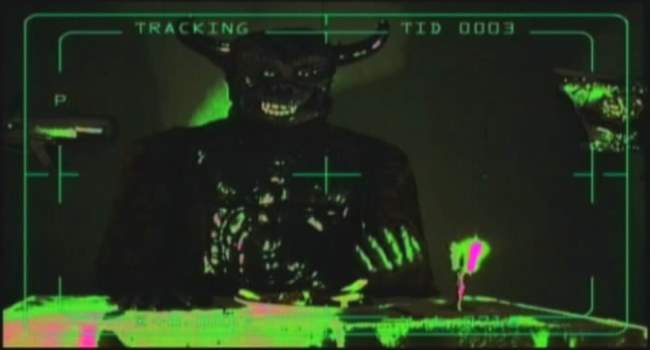
Unfortunately, the poor pesticide robot puppet has nightmares about hell. His response to the rubber demons? He treats them like big breasted chicks and chops them up!
Enter our star - the deranged robot exterminator puppet. For his day job, he’s supposed to be killing the large rubber cockroaches that keep frequenting the bare-breasted chicks’ apartments, but due to a eeeevil after-market robot parts salesman, now he looks at these chicks as bad girls who need his special services. But this is no ordinary deranged robot exterminator puppet. He’s also a master hacker and top micro-electronics expert - he can create his own robot bugs that break into bare-breasted chick apartments! Better yet, he can instantaneously rip out a wall in the exact size of his human-sized robot puppet body, but can also shrink small enough to sneak through the small air ducts that permeate every big-breasted chick abode.
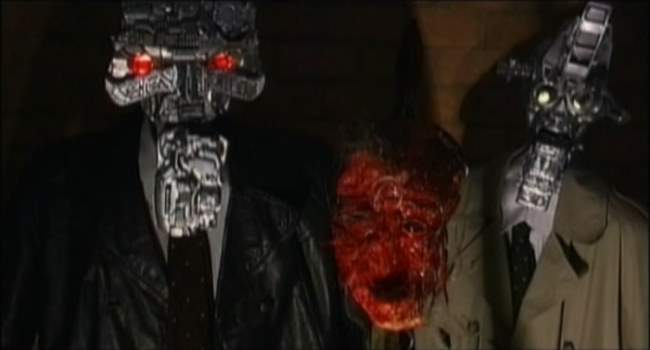
Exterminator City Dialogue Moment:
Police Detective Robot Puppet: “I knew this girl.”
Mad Psychologist Robot Puppet: “You did?”
Police Detective Robot Puppet: “I put her away on three counts of drug violations.”
Mad Psychologist Robot Puppet: “I’d say she’s cured.”
Meanwhile, a bumbling police detective robot puppet is on the case. He may seem useless but he’s sure he’ll catch the bad guy. What’s his strategy for success? He hangs out with a mad psychologist robot puppet (who used to have the pest control robot puppet as a patient) and discusses each gruesome murder after it takes place. Usually they like to mount the most recent dead, bloody and now skinned big-breasted chick on a poll between them (see above) so they can discuss the specifics of her death.
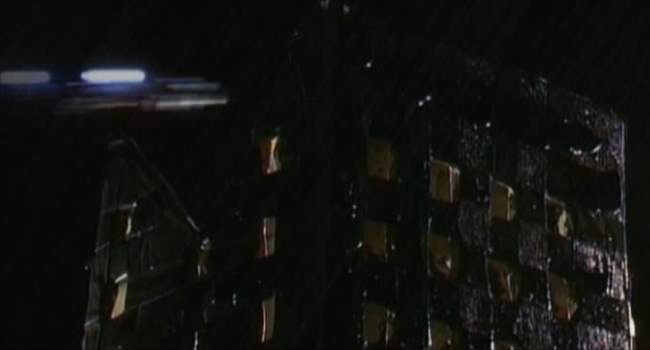
This is the “Blade Runner” police HQ. Yes, in fact it does look like a cardboard box with squares cut out, covered with overlapping strips of spray-painted construction paper. But at least the light stays on, and the zippy things, which are supposed to be the police car, wiz by fast enough that you never get a good look at them.
The Pacing: The pacing in Exterminator City mimics standard porno movie. There is a brief, incoherent beginning scene, followed by a series of action shots that are broken up by brief, incoherent interludes. In this case, robot/bare big-breasted chick slasher porn comprises the action shots. The ending resolution ending scene bookends the front in that its also an incoherent moment that nobody cares about. Between each slasher porn sequence, he interlude shots in Exterminator City always start off with a fast light-car zipping past the cardboard building above followed by an inane puppet dialogue moment. Most often, the dialogue moment involves ridiculous conversations (or sword fights) between the detective robot puppet and the mad psychologist robot puppet, but sometimes we get a “hell” fantasy from the mind of our anti-hero pest control robot puppet. I’m guessing Cohen was trying for a “Space Ghost Coast-to-Coast” type feel for the interludes, but this is just a guess (he failed).

You can tell this scene is still early in the movie because the chick is hawt, can scream well and eventually takes off her top. Later on we get semi-ugly chicks, chicks that can’t scream or worse, ones that won’t disrobe!
Where Did the Big Breasted Chick Footage Come From?: While I know nothing about the making of this movie, I’d bet money that director Clive Cohen has never met any of these chicks. Far more likely, I’m guessing that Clive contracted with some cheesy modeling agency that had pre-made clips of all their “actresses” in a horror-scream type setting. In NONE of the 20+ bare-breasted chick killing scenes do we get any sense that they have a clue what’s going on. Basically, each of them are in some kind of current-day house setting (working out, taking a shower, watching TV, etc.). After a few seconds of relaxation, they look toward the camera and start screaming. The scene then cuts to the deranged robot puppet axing, chopping, chainsawing or bludgeoning through fake skin of some kind. Julie Strain is the only one given more than 40 seconds screen time (she gets like 3-4 minutes). What’s truly funny about this approach is how bad these chicks really are - not only in acting, which is expected, but in screaming. Some are truly horrid.
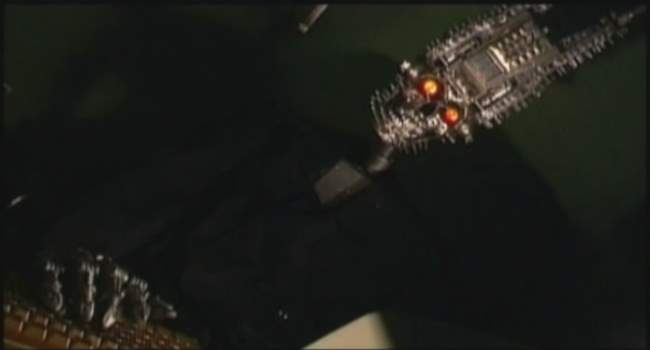
Robots need keyboards to hack into the police database!
Exterminator City Dialogue Moment:
Police Detective Robot Puppet: “He ain’t coming back here no more”
“What makes you so sure?”
Police Detective Robot Puppet:”He had a trace on our trace. He knew we were watching him.”
“So he won’t hack the system again?”
Police Detective Robot Puppet: “He don’t have to. He downloaded all files on route to the kill.”
“So no stopping him now?”
Police Detective Robot Puppet: “You must be sooo proud.”
“No detective. I am not.”
Police Detective Robot Puppet: “I’ll get him”
“How can you know that?”
Police Detective Robot Puppet: “That’s my job, bitch.”
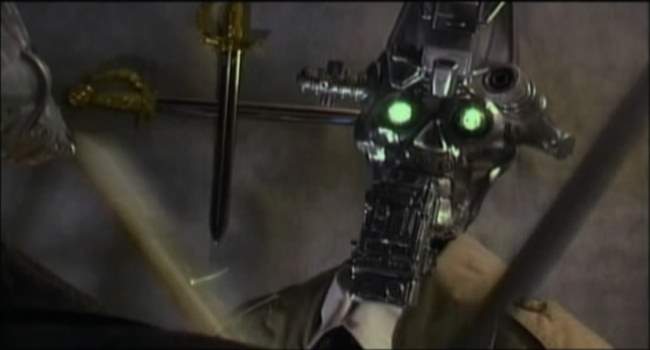
And then a random plastic sword fight breaks out between the police detective and the mad psychologist. Why you ask? Um, don’t ask why…Incidentally, in the close-ups of both puppets, they each have those crossed swords behind them (apparently the walls move quickly to keep the crossed swords in the shot). I think this is to help the viewer recognize that they are having a sword fight.
The Bottom Line: Often when watching a truly horrid flick, you find yourself wondering, “What did this director really want to accomplish?” In this case, its pretty clear - Cohen wanted to make robot slasher porn. Unfortunately he didn’t have a budget, so he settled for robot puppet slasher porn that occurs off-screen. As bad as this “movie” is, I must say that a good number of the big-breasted chicks look really good. And I suppose there’s something to be said for having massive quantities of big breasted chicks to make up for the monstrosity that is this movie. I honestly doubt that anyone besides Cohen actually worked this thing.
But give Cohen some credit: like any good porn movie he knows to keep the better action shots near the beginning, as most will tire of the movie long before the ending comes. As we get to the last third of the movie, the women are either uglier, really awful screamers or won’t take off their clothes. For this organization philosophy, I’m giving Cohen an extra star in my rating (which brings my review to a grand total of 2 stars!). Unfortunately, this approach also means that near the end, we’re stuck with a higher dose horrid dialogue between the detective and psychologist, along with the occasional rubber hell monster. Bottom line, if you do have a hankerin for big bare-breasted robot puppet slasher porn and need to see this, don’t feel guilty in turning it off just after the halfway point.
Movie Review By: Dan Swensen
Year: 1981
Directed by: Michael Crichton
Written by: Michael Crichton
IMDB Reference
Degree of Cyberpunk Visuals: Low
Correlation to Cyberpunk Themes: Medium
Key Cast Members:
- Larry Roberts: Albert Finney
- Cindy Fairmont: Susan Dey
- John Reston: James Coburn

Uneven, satirical, and oddly prophetic in its own half-baked way, Michael Crichton’s 1981 film Looker takes place in a terrifying universe of glamour, dehumanization, corporate deception, and Susan Dey hooking up with Albert Finney.
SFAM NOTE: We welcome new reviewer Dan Swensen, who also runs a terrific Sci-Fi blog called the Dimfuture.net. If others are interested in joining the review team, please post a message in the review forum.
Overview: The year is 1981, and pudgy, befuddled plastic surgeon Larry Roberts (Finney) becomes involved in a mystery when one of his models, dissolved in tears, arrives in his office raving hysterically about mysterious people trying to kill her. Hours later, the model inexplicably falls from the window of her high-rise apartment, and evidence of foul play points to Roberts himself. Justifiably concerned, Roberts begins playing amateur detective, teaming up with his patient (the vapid and insecure Cindy Fairmont, played by Susan Dey) to find out what’s really happening to these models, who seem to be dying off in droves shortly after visiting Roberts’ office to be “perfected.”
Mostly relying on the incompetence of the antagonists and the near-complete apathy of the cops, Roberts eventually tracks the clues back to a company called Digital Matrix, a computer graphics and advertising firm that specializes in creating digital replicas of top commercial models. While these models are given lucrative contracts in exchange for their digital likenesses, they seem to mysteriously die shortly thereafter, their handsome royalties left unpaid. It doesn’t take long for Roberts to figure out that Digital Matrix is duplicating these models, then killing them off, as their “digital doubles” will do their job better — and for free.

Machines and Misogyny: In an age where digital replacement and enhancement of actors is now extremely commonplace, Looker seems both surprisingly relevant and woefully dated at the same time. Penned in by Hollywood’s desire for complete perfection, the models of Looker fret over millimeter-sized flaws, consumed with self-loathing over even the slightest imperfection. As the story progresses, the audience finds this to be more than mere vanity — in Crichton’s world, Digital Matrix has reduced human behavior to a set of algorithms, able to determine (and manipulate) the focus of a viewer’s attention with ultimate precision to maximize product exposure and desire.
Because these manipulations require inhuman accuracy, the models themselves soon become not only obsolete, but liabilities to the company. The theme of dehumanization — the models looked upon by the corporations, and themselves, not as human beings but commodities to be used up and thrown away — is very strong in the first half of the film, underlined by a casual misogyny that may or may not have been intentional (it was 1981, after all).

In addition to the prophetic “digital doubles” of the film, Looker’s most science-fiction invention is the L.O.O.K.E.R. device (short for Light Ocular-Oriented Kinetic Emotive Responses), a “light gun” that stuns and paralyzes the target using light. Anyone exposed to this weapon experiences a sort of “missing time” as they stand paralyzed, allowing the weapon’s user to move around, invisible and undetected, for short periods. Digital Matrix uses the device to cover their tracks, making the models’ deaths appear as suicides.
While Looker is more than a bit plodding at times, the film’s use of this device is undoubtedly the most clever effect in the film, as characters find themselves losing time without knowing how or why. (It’s also worth mentioning that the L.O.O.K.E.R. device is the movie’s only real special effect, and provides the film’s most interesting visuals.) The L.O.O.K.E.R. device is a neat little concept, one I wish could have gotten better treatment in a better film.

The Bottom Line: Unfortunately, Looker is a movie with a few good ideas that don’t quite survive the runtime. The last half-hour of the movie is an extended game of “humorous” cat-and-mouse in which the heroes and villains chase each other through a virtual landscape of digitized commercials — the best of which is a genuinely macabre moment featuring digitized kids complaining about their breakfast cereal as a real human lies dead on the prop kitchen table.
While these scenes are mildly funny on a multitude of levels (the style of commercials, for all their “digital” glory, are more akin to something out of the Fifties than anything out of science fiction), they’re out of tone with the rest of the film. Albert Finney is no action hero, and doesn’t even have the charisma necessary to be a good everyman. Susan Dey’s character is too insecure and flat to be anything but an object of pity, and James Coburn’s turn as the villain, while passable, is too brief to be interesting.

A mustachioed Eighties thug gets a taste of the L.O.O.K.E.R. device.
That’s not to say that the film can’t be enjoyed as good cheese, however — there are some amusingly inept moments (watch for the car “crashing” into the fountain), and the few special effects are decent enough. Overall, Looker is probably more interesting as a historical piece than as a thriller — though it’s dated badly on a number of levels, the ideas of dehumanization and artifice that it puts forth were, for 1981, surprisingly forward-thinking. It might also be interesting to note that Looker made the first real attempt at a realistic CGI character, as well as the first movie to used 3-D computer shading.
After its release in theaters, Looker haunted the bleak hinterlands of early Eighties cable television for awhile (probably sandwiched somewhere between showings of Krull and The Entity), and is out on DVD now. Oh, and if you care about that sort of thing, Susan Dey is naked in it.
-Dan Swensen
Movie Review By: SFAM
Year: 1966
Directed by: Franklin Adreon
Written by: Arthur C. Pierce
IMDB Reference
Degree of Cyberpunk Visuals: Low
Correlation to Cyberpunk Themes: High
Key Cast Members:
Gareth A7: Michael Rennie
Dr. Karen Mason: Karen Steele
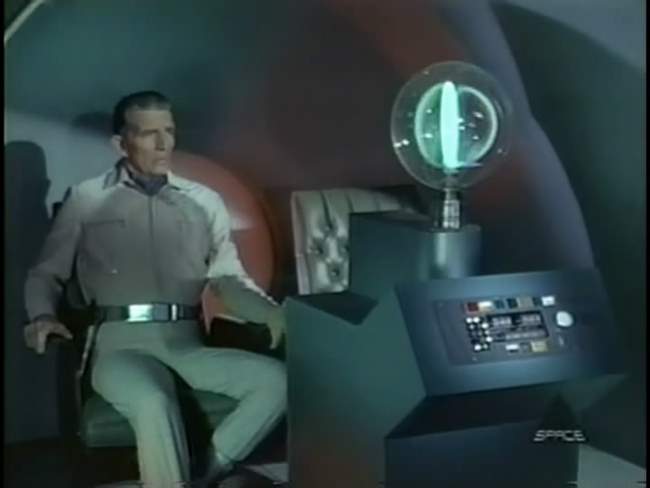
Overview: On its face, Cyborg 2087 sounds like the plot for the terminator: this guy from a dystopic future comes back to the past to stop the development of a new technology with lots of promise, that ends up destroying humanity as we know it; unfortunately, he is chased by these cyborg things who are bent on stopping him. While there are certainly some similarities, the differences are perhaps broader. Aside from the obvious budget differences, the plot in Cyborg 2087 involves a cyborg returning from the future versus a man, and he’s not trying to perform a “retroactive abortion,” he is doing something similar to Sarah Conner in T2 – he wants to stop the technology from being released at that time.
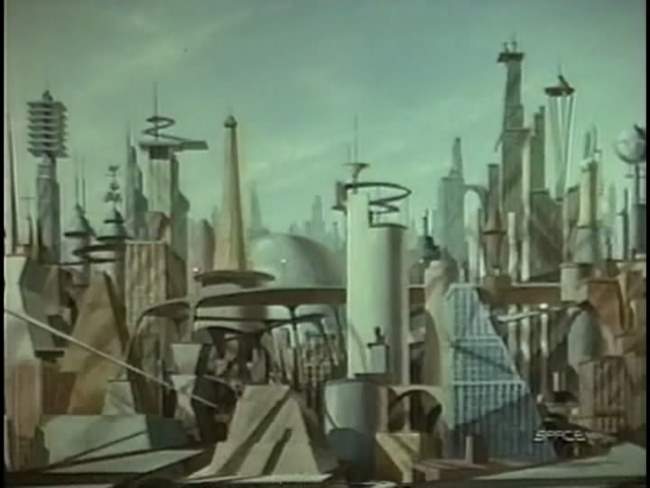
The Story Genius scientist Professor Sigmund Marx has created a technology that allows us to guide other people and influence their thoughts. Unfortunately, it turns out that this technology will be subverted by the government and military to engage in mass thought control of the population. In the future, humanity’s freewill has been crushed. Now a race of cyborgs have taken control to maintain stability. A small group of freedom fighters has come upon a method for restoring humanity. They have created a time machine, and intend to send back a cyborg who has had his “control” chip removed – the goal of which is to convince Professor Marx to abandon his experiment, or in worse case, to kill him.

The cyborg, Gareth A7 (played by Michael Rennie of Day the Earth Stood Still), doesn’t have access to all his technology when he was sent back. Worse, he has a homing beacon implanted in him that will lead the killer cyborgs, called tracers, right to him. He happens upon Professor Marx’s assistant, Dr. Sharon Mason (Karen Steele), and uses the perfected form of Marx’s technology to overwhelm her freewill and force her to assist him. From there it’s a race. The bad cyborgs from the future have arrived and are sporting killer ray guns. Gareth and Sharon must find the professor and convince him prior to the killer cyborgs finding him.
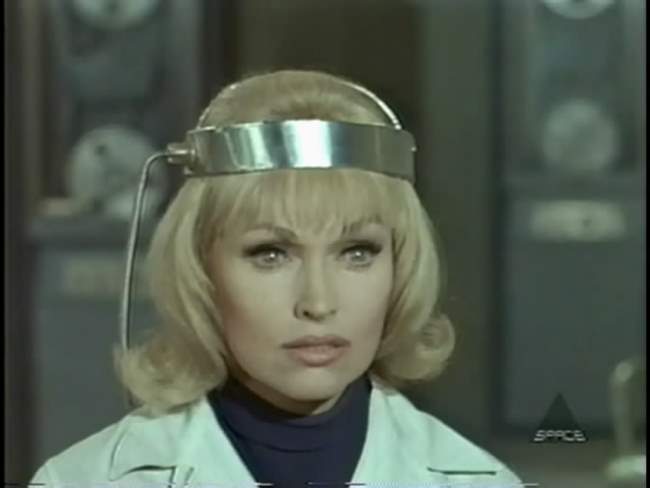
The Acting: The acting in Cyborg 2087 is fairly sub par. Aside from Michael Rennie, who I just enjoy seeing in another flick, the rest of the cast really falls short. Karen Steele over-emotes, as does her secondary love interest, Harey Carey Jr. The tracers are particularly bad, as are most of the bit characters. The Sheriff, played by Wendell Corey, while over the top, is at least well done. The bottom line here, with a budget as low as this one was, the only way Cyborg 2087 could have worked is if the acting paid off – unfortunately it didn’t.
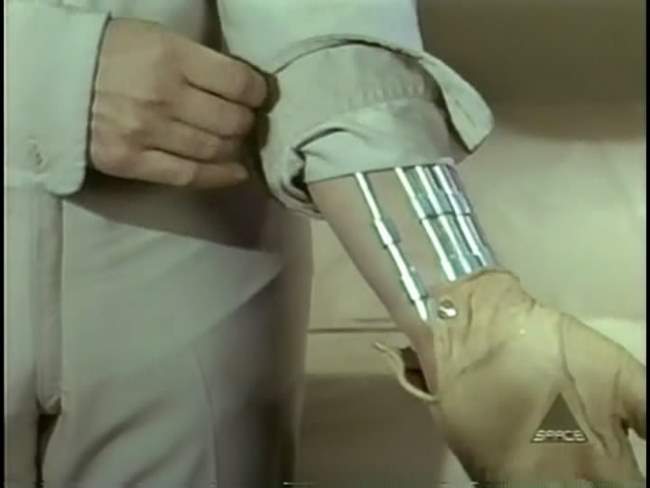
The FX: Cyborg 2087 is very low budget, so we can’t expect much in the way of realistic effects. The extent of fanciness here involves making something disappear by taking another shot with the object removed. The ray guns have the cheesy thick white light look, and the outfits are anything but high tech. The opening shot of the futuristic city, which is nothing more than a painting, is at least interesting from the standpoint that it shows you what people in the sixties thought our futuristic cities would look like. At best, Cyborg 2087 tries for the cyberpunk western look, but this too is problematic. Perhaps the worst part of the FX deals with the tracers, who are heavyset guys running around in fake US army costumes. They really coulda spent at least a buck or two to buy an extra who at least was in shape. On top of this, the cartoonish sounding score is especially atrocious. If there were any quality scenes in this movie, the score ensures that they won’t be noticed.
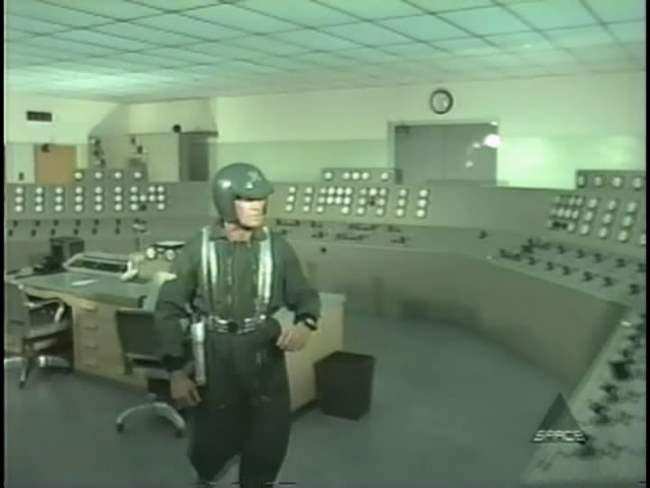
Cyborgs: In Cyborg 2087, we are told that the cyborgs are a combination of man and machine, but we really don’t get much more of a breakdown than that. We know that they have wide open spaces in their bodies, and that they have the power of five or six men. Basically, the model we get here is of regular people that basically work like simple computers, and are able to have various computer chips embedded in them. In the end, its not a very believable view of cyborgs, and isn’t even a consistent one. We are told that cyborgs have no emotion, but somehow, Gareth falls in love with Sharon. The movie would have worked so much better had he let her die near the end versus what did happen (the heroic rescue).
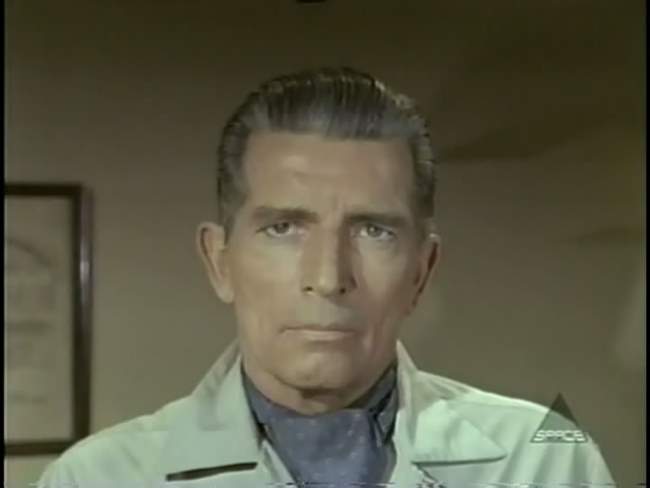
The Bottom Line: Arthur Pierce’s script for Cyborg 2087 probably mostly decent (aside for the Hollywood happy ending factor), but unfortunately Franklin Adreon’s directing talents are not enough to bring it to a successful fruition. Far too frequently, Cyborg 2087 comes across as poorly done SciFi cheese. Again, had the acting been decent, one could easily overlook the low-qual FX. Unfortunately this is not the case. However, I did find it worthwhile to watch for one reason only – I loved Michael Rennie in the Day the Earth Stood Still, and really enjoyed seeing him in another flick. His acting is pretty much the same (Stoic, serious, impending doom looking demeanor), but at least we get to see him running around and performing action scenes.
~See movies similar to this one~
Movie Review By: SFAM
Year: 1962
Directed by: Wesley Barry
Written by: Jay Simms
IMDB Reference
Degree of Cyberpunk Visuals: Low
Correlation to Cyberpunk Themes: Very High
Key Cast Members:
Capt. Kenneth Cragis: Don Megowan
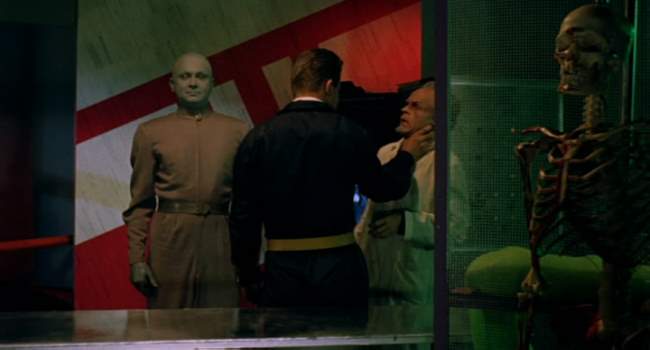
Overview: It’s a rare instance when we find a movie that has all the trappings of a “B” SciFi shlock-fest – one with an overly cheesy name, a DVD cover advertising the movie as a classic drive-in flick (as was the original marketing art), one which has the standard “B” movie high-pitched moaning female chanting alien vocal track duing the credits and a creature-feature font typeface for its title – but in fact isn’t. Creature of the Humanoids practically screams “low-budget, exploitative SciFi crapfest” but…isn’t. Instead, after digging beneath the voluminous trappings of “B” cinema, we find a very intelligent, but low-budget movie – one which in 1962 has captured a good number of the cyberpunk themes that would dominate literature and movies twenty years later. Contrary to the DVD cover, which combines Creation of the Humans with War Between the Planets (which is pretty much what you think it is), this is a slow-paced, thinking person’s movie. Said another way, I’d probably be damn bugged if I had taken a date to see this at a drive-in, but as an intelligent movie for CyberpunkReview, it works fine.
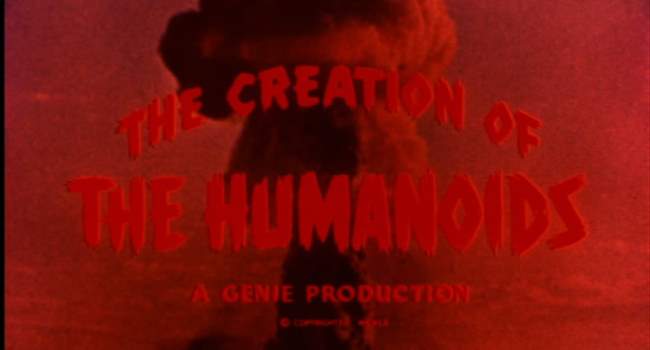
The Setting: A nuclear war has taken place, resulting in the extermination of 92% of the human race. Those that remain are riddled with radiation poisoning, leaving very few couples who can create viable offspring. To keep civilization running, the remaining humans significantly ramped up their production of robots, which now number almost a billion in total, and handle most of the mundane tasks of society. Over time, advances in AI and automation have created a “race” of robots that have become sentient, and even more capable than their human counterparts. Because humans couldn’t stand working next to machine-looking things that seemed smarter than them, robots began being constructed to emulate humans. Now, 20% of all robots look humanoid in nature. However a backlash has formed - a hate group called the “Order of Flash and Blood” is pushing for the ban on all humanoid-looking robots. Because of a backlash by many humans, these robots can only look 70% similar to humans.
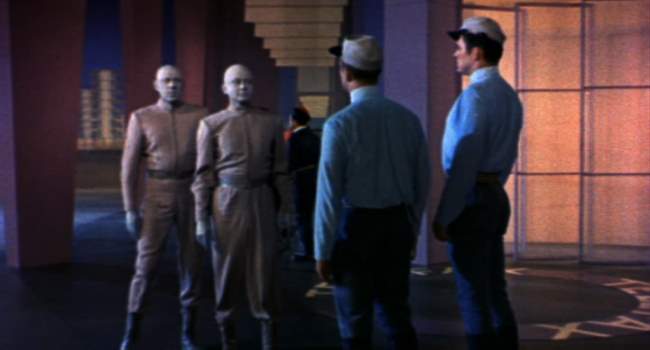
The Story: Capt. Kenneth Cragis (Don Megowan) is a leader in the Order of Flesh and Blood, the robot hate group. While on monitoring the activity of “clickers,” a derogatory term for robots, he notices some suspicious activity entering the robot shrine, a building off-limits to humans, which contains the central AI program that most robots now take direction from, and practically worship. In getting Flesh and Blood members to storm the shrine, they find a robot that looks almost fully human (96%) who has just killed a rogue scientist. As robots are all programmed to follow what essentially are Asimov’s three laws of robotics, this constitutes the first instance of a robot killing a human. Cragis sees this as an opportunity for the order to finally break-through and convince the human leadership of the righteousness of their cause. But in analyzing the human-looking robot, they discover something horrifying – it turns out that this robot actually “thought” he was a person, and appeared to have been created by taking the essence of a person recently dead, and replicating them inside of a robot.
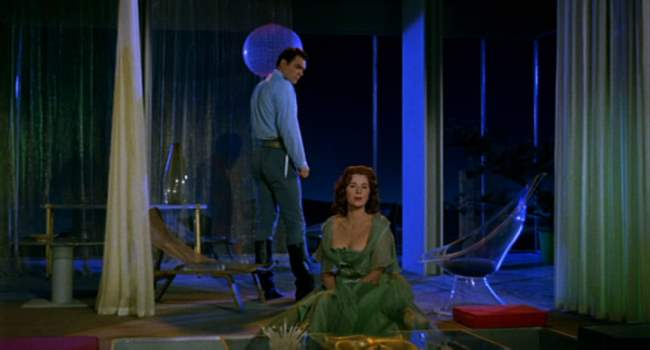
Cragis also has another dilemma, his position in the order is now threatened, as its come to light that his sister has recently entered “rapport” with a robot named Pax. When in rapport, the robot and human essentially share the same mindset – everything his sister desires is instantly understood by the Pax and her needs are met. They are essentially soul mates. Cragis and his sister are on complete opposite sides of this issue, and there is no way for him to convince her otherwise. But things go from worse to weird when Cragis, and his newly found love (Erica Elliott) discover a truth about themselves that will shake the foundations of humanity.
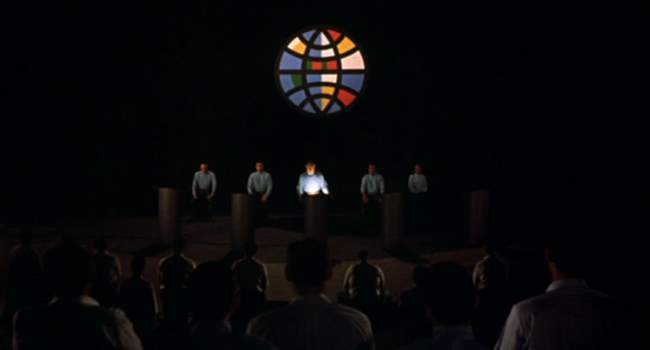
The Production Values Suck: If I were grading Creation of the Humanoids based on production values alone it would be grateful to achieve even a three-star rating. From a production value standpoint, this movie is poorly made. The very few sets that exist look like warehouse sets quickly done up with extra junk from other SciFi movies and the only music accompaniment used everywhere (including love scenes) is the eerie “alien ship is coming” sound. The FX, especially of the robots are very poor, consisting primarily of bald-hair pieces and green makeup. Aside for a few of the leads (Don Megowan, the most important character is decent) is sub par at best. From a production value standpoint, Creation of the Humanoids seems far better suited to a play than a movie. If fact, I wouldn’t be at all surprised if this was the original intention of Jay Simms’ script. The DVD treatment, which provides a far better than expected transfer, essentially tries to mimic a drive-in movie experience. This is annoying it that there is no chapter feature. You are forced to click through the upfront stuff, the first feature, and the intermission crap to even get to Creature of the Humanoids.
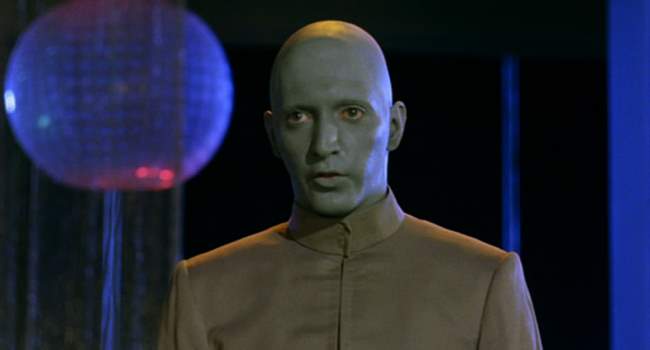
If a Man Loses His Leg, Is His Soul Affected? this is the question posed by Creation of the Humanoids. If one answers that the soul is not affected, the follow-on thought is what if the whole body was replaced but that the essence that is “you” survives in an android shell. Do you still have a soul? If not, when did you lose it? Creation of the Humanoids provides us a world where humans are quickly becoming extinct, and where their salvation is going to be a situation where their personalities – all that makes them unique – are transferred into robotic bodies. They even will still be able to procreate, after a fashion. So the larger question this movie finally poses is: in this completely post-human world, does humanity still exist?
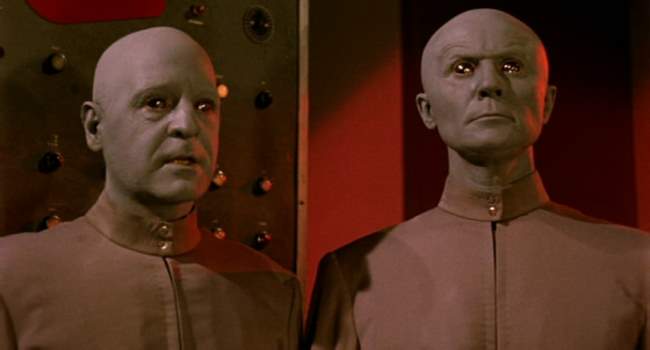
Replicants in Years Past: While Blade Runner is most often credited as having the definitive replicants, clearly this idea has been around for a lot longer. In Creation of the Humanoids, robots that are 96% human capability are created by taking a recently diseased person (within six hours of death) and extracting all that is unique about them (their memories, learning, skills, philosophy, etc.) and inserting it into a special thalamus chip to be integrated into a robot’s cerebral cortex processing unit. In doing so, they wipe all memory of the human’s last moments (their deaths). The end result are robots that still think they are human. For all times other than between 4:00 – 5:00 am, the robots act completely human. But during that one hour, they remember who they really are and report back to the robot society.
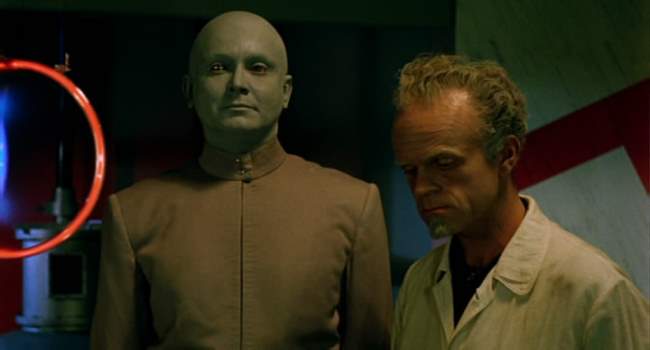
Asimov’s Laws Were Already Being Followed By 1962: Creation of the Humanoids gives us a glimpse of the incredible influence that Asimov’s “I, Robot” a mere 12 years later. The Robots in this already adhere to the laws, and have already worked out methods to break them. Robots must never harm other humans, and must always work to serve their best interests. Yet, unfortunately, humans don’t always know what is in their best interests, and thus, the robots must become subversive to meet this law.
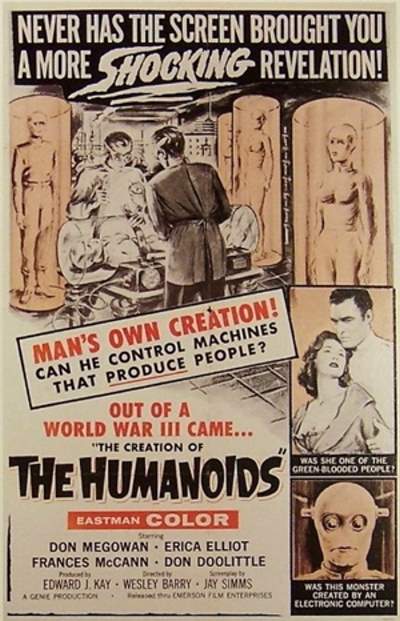
Clearly, this movie was created and marketed as a creature-feature. One can only imagine the disgust that writer Jay Simms had to this bastardization of his overly thoughtful script.
When Robots Control Humanity: One of the more interesting arguments Creation of the Humanoids engages in is the question of what life will be like if and when the robots control mankind. In this movie, the robots have already gained control of who is in gets elected, even though the regular populace has no clue this has occurred. The robots also engage in subtle methods of mind control and brainwashing, all to make the populace more accepting of robot rule. Because the robots believe humans do things not in their best interests, it becomes their duty to “manage” human life. The question is then raised whether humanity will still want to pursue knowledge and self-betterment – after all, what’s the point if everything you even think you might want is automatically provided for you? The answer is rather depressing here – it has already happened – that we’ve just now realized it is almost irrelevant.
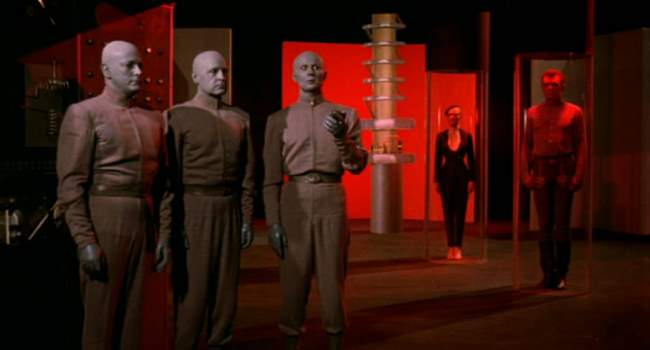
The Bottom Line: While the production values suck, the story in Creation of Humanoids is both complex and interesting. Many ideas presented are wonderful grist for later books and movies. As long as you realize that the production values in this flick make the old Dr. Who series look high-tech, you’ll probably enjoy it. While it is very slow-paced and only has about 5 separate scenes, the ideas presented are interesting enough to keep your attention. Aside for the commentary on race relations (obviously a big issue in the early 60s) Creature of the Humanoids makes us think through some interesting notions of post-humanity. While I’d give it 3 stars for its production values, I’d give it an 8 star rating for its story. This won’t appeal to everyone, but is certainly good enough that it shouldn’t be forgotten.
~See movies similar to this one~
Movie Review By: SFAM
Year: 1995
Directed by: Stephen Norrington
Written by: Stephen Norrington
IMDB Reference
Degree of Cyberpunk Visuals: Medium
Correlation to Cyberpunk Themes: Low
Key Cast Members:
Jack Dante: Brad Dourif
Hayden Cale: Ely Pouget
Sam Raimi: John Sharian
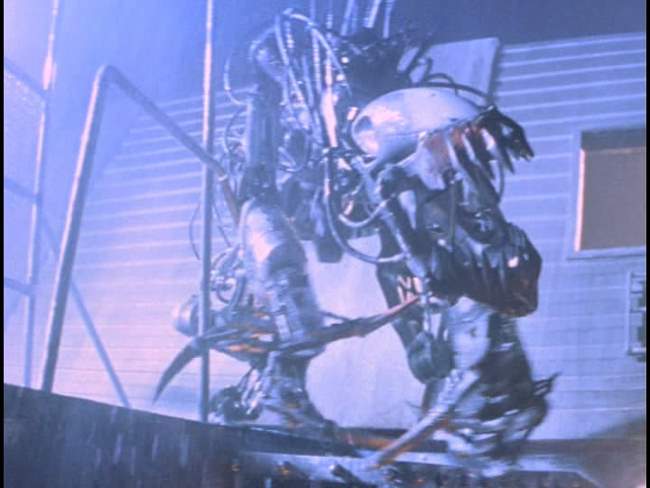
Overview: In yet another of the Alien/Terminator copycat movies, Death Machine is a low-budget, poorly thought out shlock-fest that tries to dazzle you with a largely incoherent in-depth plot and over-the-top acting. While another virtually unknown British Director, Richard Stanley, scored big in a similar but far more original copy-cat movie, Hardware, Stephen Norrington’s Death Match just doesn’t cut it. These types of movies live or die on the overall atmosphere and the quality of the fear the creature engenders. While Hardware excelled on both counts, Death Machine falls woefully short. Worse, Death Machine makes a lame attempt at humour by naming all the bit players with the names from the movies Norrington stole plot bits and visuals from (John Carpenter, Scott Ridley, Weyland, and Yutani)
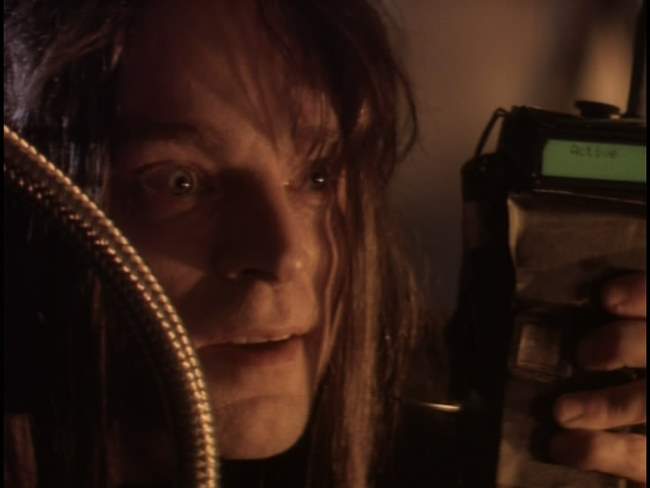
The Story: In the near-future, the evil Chaank Armaments corporation has engaged in a number of shady, classified project that have resulted in dissapearances and potential deaths. Public outcry has gotten out of hand, so for damage control, they bring in an upstanding principled new chief executive named Hayden Cole (Ely Pouget), a hot chick with a porn past to inspire trust and confidence amongst the masses. As she delves into things, it’s clear that the board of directors wants nothing to do with providing full disclosure. Why? Because there is an evil genius mad scientist in the basement named Jack (Brad Dourif), who has the dirt on everyone, and is hard at work at making a death machine to keep everyone in line. Additionally, Jack has created a process for transforming humans into killer-cyborgs. Unfortunately, this process is flawed, and all the cyborgs end up dying.
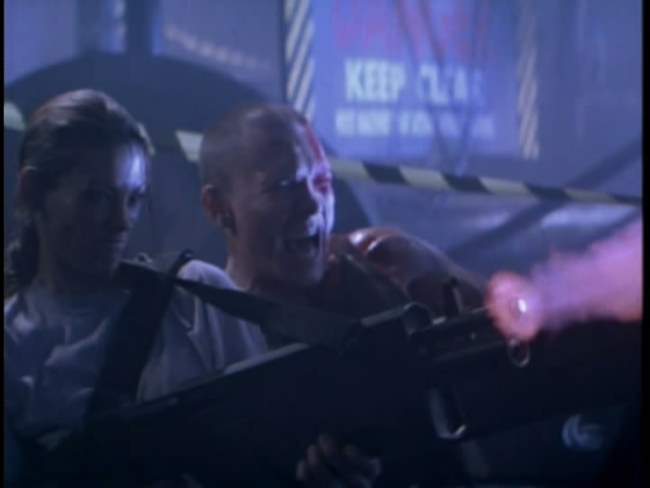
Eventually, the hawt chief executive challenges Jack, and all hell breaks loose. She and a few others become trapped in the building with some would-be amateur freedom fighter cyberpunk types who have invaded the corporation in the hopes of destroying it. Now they are all just trying to escape the robot known as the War Beast. Hayden and Sam Raimi (John Sharian), the leader of the amateur terrorists, spend the rest of the movie trying to evade and eventually kill the War Beast. I could go into more of the plot, but truly, its just not worth it.

The Robot Monster: OK, so we have this really tough robot thing – virtually indestructible. Anyone wanna tell me why this robot has like a hundred rubber tubs hanging out, and nobody who fights it in hand-to-hand combat thinks of grabbing them? More to the point, why don’t the thousands of rounds of bullets affect the tubes? Bottom line, this robot was more silly than scary. In Hardware, the robot was continually shown moving quickly in low-light situations. This allowed Stanley to get away with a low-tech, but very believable robot. Unfortunately, Death Machine doesn’t take this approach – it shows the robot in detail to make sure you see its faults. Color me not impressed.
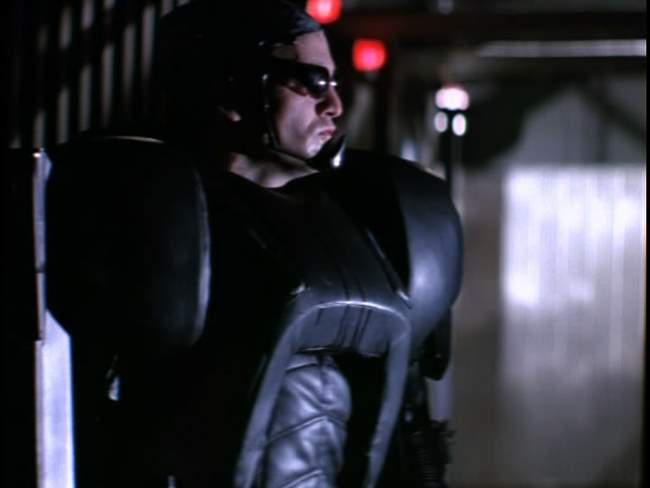
Yes, ladies and gentlemen, you can tell this is a cyborg because he’s wearing sunglasses. Also, he has that really big vinyl and plastic whatever-the-fuck-it-is on - DEFINITELY a sure sign of a cyborg warrior!
Death Machine’s Approach to Cyborgs: In Death Machine, the Chaank Armaments Corporation creates cyborgs by wiping someone’s memory and uploading it with detailed weapon systems training, and simple goals (e.g., protect me, seek out and kill “guy X”). In short, its approach to cyborgs assumes the human mind is synonymous with a hard disk. They even have an instance where a key character’s personality “backed-up” and then wiped from his mind to allow the “warrior personality” to be installed, and then later, they reload the initial personality. Puleeze, Norrington! I’m sure you coulda come up with a marginally believable cyborg warrior rationale. Too bad you didn’t take the time to think of one.
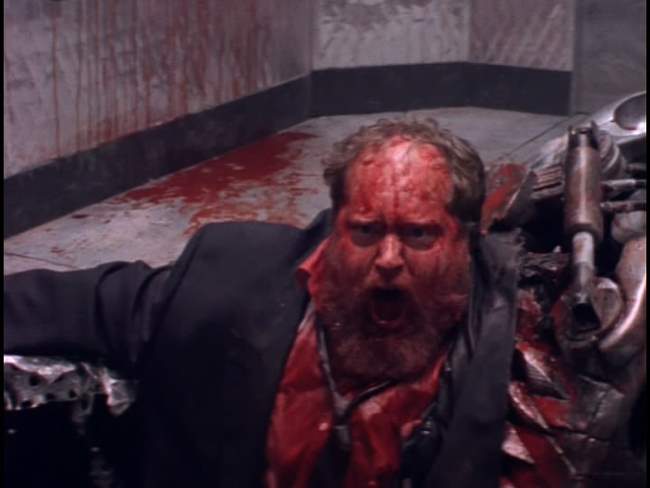
The Bottom Line: Truly, to even have a chance of being watchable, Death Machine would have needed to incorporate a heavy dose of T&A. While Ely Pouget has the looks, this never materializes. This is all the more annoying in that the inclusion of the porn reference flat out portends juicy T&A. Instead, we’re left with a shlock “B” movie, absent of T&A, without the effects, acting, plot or monster to carry the day. Brad Dourif’s character, while mildly amusing is just too over-the-top to stomach, and nobody else other than Pouget even stands out. Even worse, they screw up what should have been a very simple ending (this may be the only original part of the movie - in retrospect, Norrington should have copied this as well), leaving us with a almost complete let down, and no payoff for sticking around for 2 hours. In short, I don’t see much to recommend here.
~See movies similar to this one~
Movie Review By: SFAM
Year: 2000
Directed by: Allan Moyle
Written by: Christopher Pelham
IMDB Reference
Degree of Cyberpunk Visuals: Low
Correlation to Cyberpunk Themes: Medium
Key Cast Members:
Clone #1/Toffler 3: Stephen Baldwin
Toffler/Fisk 2: Kim Coates
Fisk/Toffler 2: Kyle MacLachlan

Overview: Xchange is one of those movies that comes up with an interesting if unbelievable Sci-Fi premise (mind transference technology) and then proceeds to hose it beyond all recognition with a horrid script, bad acting and flat out bizarre (not in a good way) scenes. Still the initial idea about exchanging conscious minds is interesting enough to at least keep you watching for the first 20 minutes or so. Whether you care to after that is truly a matter of how much you like trashy cyberpunked Sci-Fi.
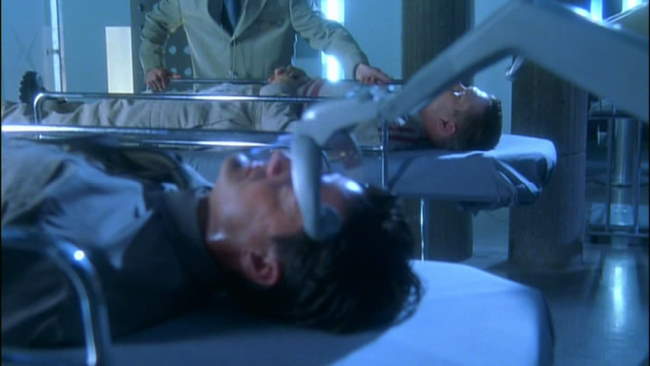
The Setting: In the near future, the technology can enable a person’s consciousness to be exchanged with another. So while you may take on the speech patterns of the new “host,” your thoughts and memories are still “yours.” Furthering this technology, a company, Xchange, now uses this technology to enable instant travel across the globe. You just need to go into an Xchange office, agree upon a temporary host (male or female), and plug-in. But wait, there’s more! In addition to Xchanges with humans, the Xchange corporation has also created disposable clones with supra-human abilities that are ready-made to accept a temporary mind transferal. Unfortunately, the clones only last a few days before self-destructing (one might wonder how the development of a full human clone that only lasts two days could possibly be cost-effective, but, um, this isn’t really explored). Unfortunately for society, the near-future has turned onto a world of the haves and have-nots, where corporations sit on top of a society where life is only valued if you are a corporate stooge.
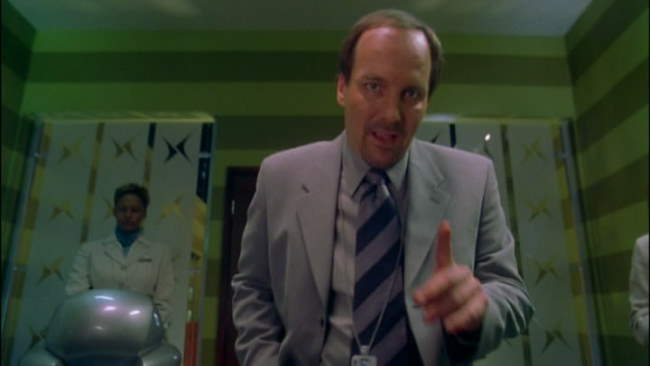
The Story: Toffler (Kim Coates) is a corporate executive who has it all. His one fear is that he’s afraid of undergoing mind transferal travel, or “floating” as it has become called. Unfortunately for him, his biggest corporate customer’s CEO has been murdered and the CEO’s son needs him by his side in an hour for an important meeting on the other side of the country. Due to the time issue, Toffler is forced to undergo his first floating instance. A temporary host has been found at the last minute, so everything seems to be set. While the transferal and meeting goes off without a hitch, and in fact Toffler (now Kyle MacLachlan) has found the experience to be enjoyable, problems arise when Toffler goes back the next day to transfer into his own body. Unfortunately, the temporary host that now is traveling in Toffer’s body has not returned – worse, his current body appears to be stolen, and the Xchange corporation is asking for it to be returned. In fact, it appears that the most notorious terrorist now is in control of his body.
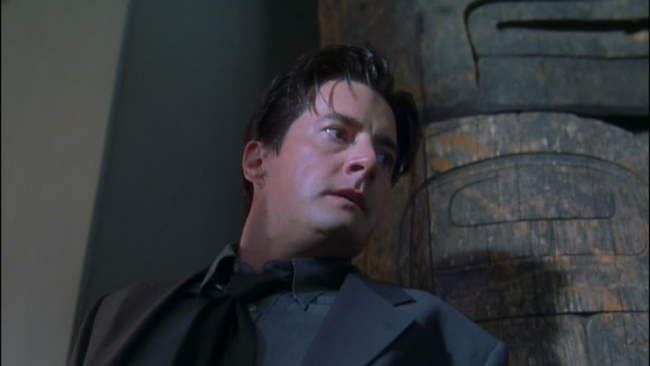
The CEO for Xchange (Janet Kidder) asks Toffler to take on the body of a clone until his real body is found. This is Tofflers’ worst nightmare. Considering clones only last a few days or so, Toffler freaks out and escapes. Strangely, he eventually gets someone to put him in a clone (Stephen Baldwin) anyways so that he can go out and find his body. From the moment Toffler escapes until the end, we get a completely bizarre and convoluted plot of corporate slimes treating the little people like trash, and screwing whoever they need to get to the top. I could go into details, but truly, for the most part it’s about as predictable as you can get.
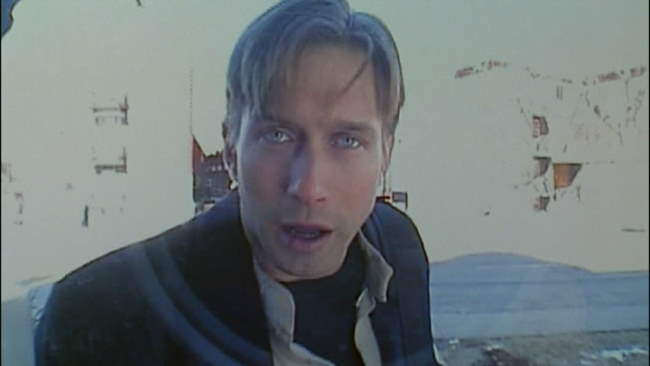
Scenes Too Stupid for Words: OK, Xchange is almost worth sitting through just to see the quick-cut shot of the CEO chick in the buff screwing the son bad guy while arguing about their absurd take over the world plan at the same time. The narrative called for the beans to be spilled on who the bad guys were, and why they were working together, so, for whatever reasons, they tried to combine the two scenes into one. Truly, this has to be one of the most idiotic sex scenes ever put on film. There are others in Xchange that are pretty bad, where similarly, something has to happen in the narrative but they couldn’t bother spending more than 10 minutes coming up with the details. But truly, the CEO sex scene has to be seen to be believed.
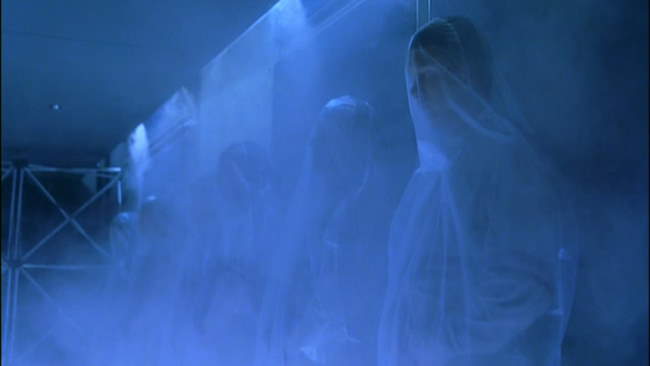
The Bottom Line: The mind transfer technology in Xchange could have potentially been interesting, but instead it is delivered in a completely simplistic and non-believable way. Worse, the surrounding story sucks horribly, and the acting, especially from Stephen Baldwin is pretty lousy. But again, the story idea was at least interesting, as was the bizarre floater bar. And the production values were at least on par with TV movies, so Xchange earns a solid 4 stars.
~See movies similar to this one~
Movie Review By: SFAM
Year: 1986
Directed by: Shigeru Izumiya
Written by: Shigeru Izumiya
IMDB Reference
Degree of Cyberpunk Visuals: High
Correlation to Cyberpunk Themes: Medium
Key Cast Members:
Lead Researcher (Male): Takichi Inukai
Lead Researcher (Female): Rikako Murakami
Third Researcher: Shigeru Izumiya
Guernica (Android): Mari Natsuki
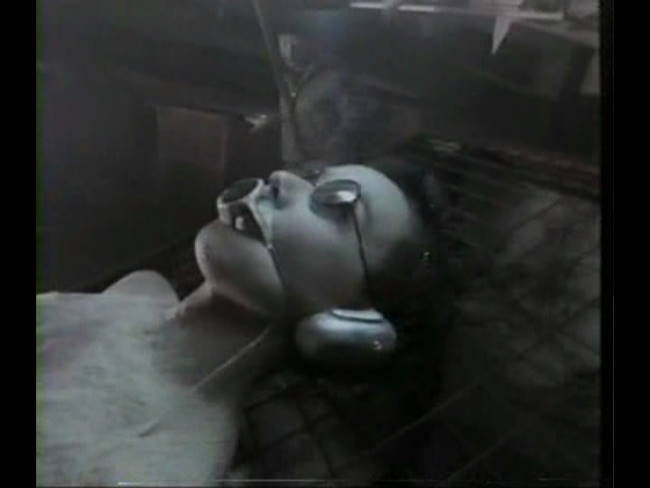
Is there life without death?
Overview: Here I yet again delve into the world of the experimental extreme Japanese Cyberpunk – this time to watch Death Power (Desu pawuda in Japanese), a movie Glam Creature discovered for me. Death Powder is a very low budget, mostly incoherent extreme Japanese Cyberpunk film with some occaisionally very interesting visuals. I probably would have liked this movie more had I obtained either a decent transfer or full subtitles. Unfortunately, the only place I could find this at the time was on LostSilver.com, a site that presses public domain movies to DVD-R format. All the main characters had appropriate subtitles, but the vast amount of mumbling in this film (mumbling usually occurred ultra-bizarre situations) was only subtitled in Chinese. The transfer was so bad that in some scenes the screen appears pixilated.
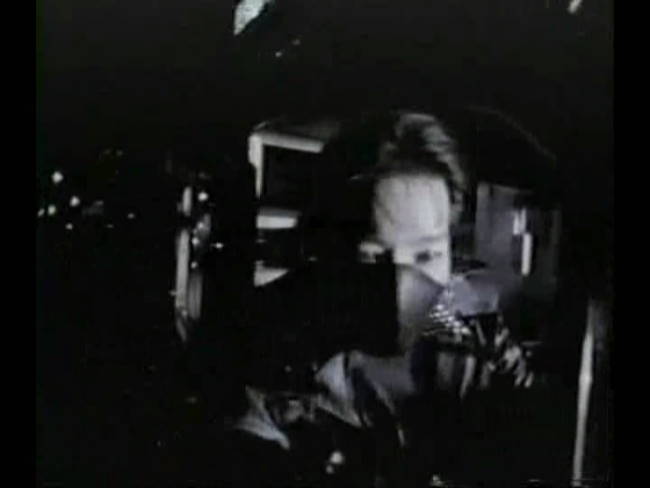
The Story: In the very near future, a group of three researchers has captured a very special android named Guernica (Mari Natsuki), and have brought her to a deserted warehouse, and have tied her to cot, with a protective covering over her mouth. One researcher (Izumiya) is left to guard the Guernica, but appears to be slowly going crazy. Two of the researchers, a guy (Inukai) and a girl (Murakami) apparently have just escaped (presumably from some fallout after capturing Guernica) and are on their way back to the warehouse. Murakami tries calling Izumiya and discovers that something is wrong.

They proceed carefully into the warehouse where they discover that Izumiya has gone crazy and is now trying to kill them. Izumiya makes it to Guernica, who suddenly sits up and blows dust all over Izumiya. From there, the movie turns extremely surreal. Guernica’s body slowly disappears into dust, while Izumiya’s face starts to expand dramatically (in a very low-budget sort of way), while Izumiya rips his hand off and Inukai shoots Izumiya with a futuristic looking gun. Things settle down with Izumiya off hallucinating, while Izumiya has somehow captured and tied Inukai to Guernica’s metal cot. She gets free and beats Izumiya to a pulp.

Sometimes death is the ultimate statement.
Meanwhile, Inukai’s hallucinations have provided him omniscience. Inijai proclaims, “”I understand the secrets of the flesh.” He sees Guernica’s origins and the ongoing struggle with the scar people, who are people who’s flesh is slowly decaying on their bodies. Things get even weirder from there with visuals of massive globs of oozing puss creatures with eyes, an incoherent video montage, a fight with the scar people, and in the end, we find a very bizarre looking monster sitting in a vast setting of emptiness.
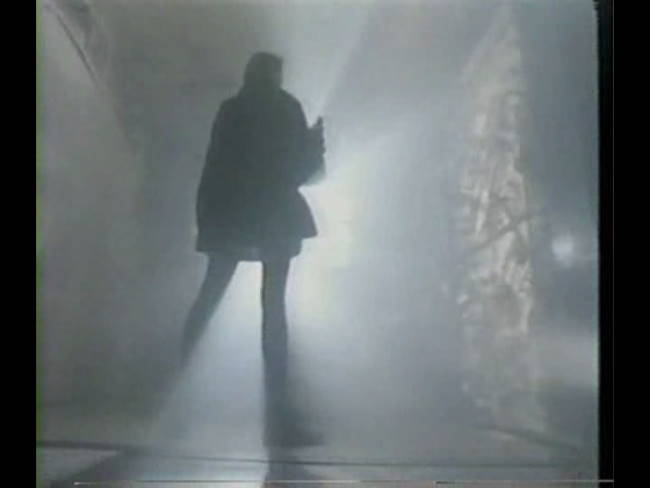
What The Fuck is This Film About??? I fully acknowledge that Death Powder is incoherent enough that attempting to interpret it will potentially lead to nonsensical ambiguity. Unlike others like Tetsuo, which CLEARLY has a point even though many claim are incoherent, this film may not simply hold together well enough to have a clear point. That being said, after two watches, it appears that the death powder is an allegory for technology’s insidious and pervasive destruction of mankind. That Android chick’s name, Guernica, after Picasso’s famous painting, gives us the clue. She is the embodiment of humanity’s destructive tendencies, and like the painting, her ultimate impact is seen with dead, injured, dismembered and torn bodies. That Geurnica is created by a rock star playing an electric guitar indicates that our technology enabled modern culture is ultimately to blame. A bastardized version Christian forbidden fruit analogy also is at play here in that a woman (android) possesses the forbidden knowledge, and humanity tries to access it by capturing her and covering her mouth. The implication is that they hope to possess the knowledge without suffering the consequences.
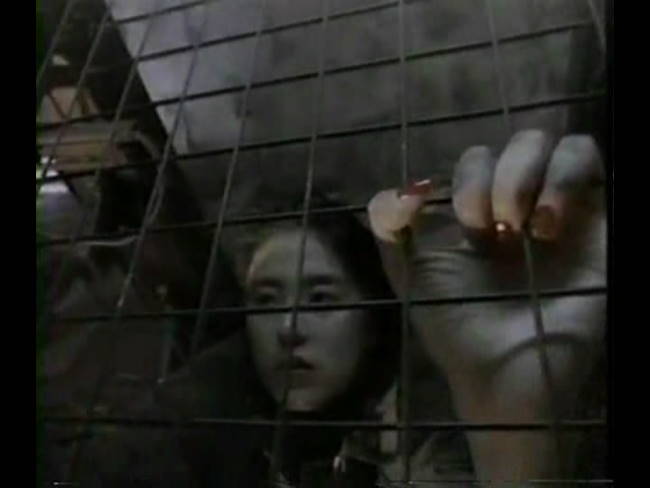
The other aspect that Izumiya seems to explore is the nexus between life and death. Death Powder explores competing ideologies in examining this question. Initially, we are told that “Life without flesh is death.” The researcher, now fully infected and potentially dead, but still thinking (meaning his flesh is dead), responds to this thought with the following:
There is no death without life. There is no Answer to this Madness.
Heaven exists within my body…dead. But Hell…Hell is everywhere!
To which, the Android, Guernica responds, “Is there life without death?” From an android’s perspective, this is probably a VERY interesting line of questioning. If you are able to think, does this not imply you are alive? But if you have no flesh – doesn’t this imply you cannot die? This is of course completely at odds with the original statement. When we include the scar people – a faceless gang of humans losing their flesh – as those espousing that life without flesh is death, we are left with a losing struggle where living humanity (flesh) is supplanted by our technological monstrosities our culture creates. In effect, Izumiya is espousing that humanity slowly dies as our culture is merged with technology. In the end, all that is left is this zombie-like monstrosity that is neither alive or dead, but definitely isn’t human.
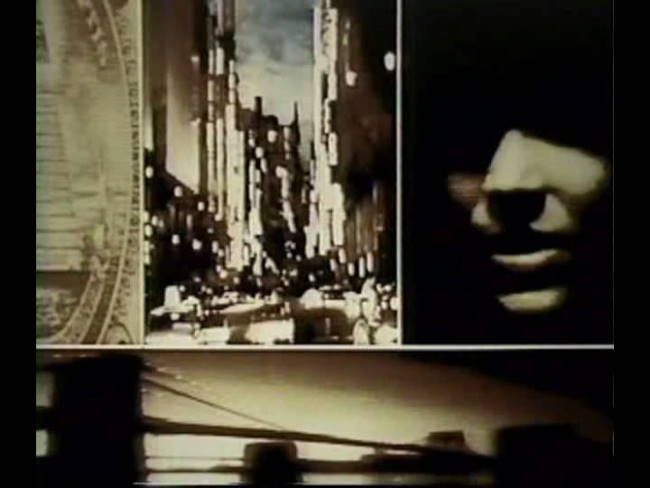
Disconnected Bizarre Video Montage: At about three-fourths through the 62 minute movie, Death Powder breaks into a ten minute plus video montage segment. This occurs after the death powder-enabled android chick states something to the effect that there are far more people to infect, so she must hurry. I’m guessing this is supposed to be Guernica’s Destroy the World tour. This would work except that when its over, we are brought right back to the warehouse, this time to await some workers who are lured into the pit of horrors. In ending it as such, the purpose of the montage seems to disappear. In the end, we are left with the idea that director Shigeru Izumiya had also developed this cool video montage footage, and wanted to include it somewhere. It does look pretty cool though.
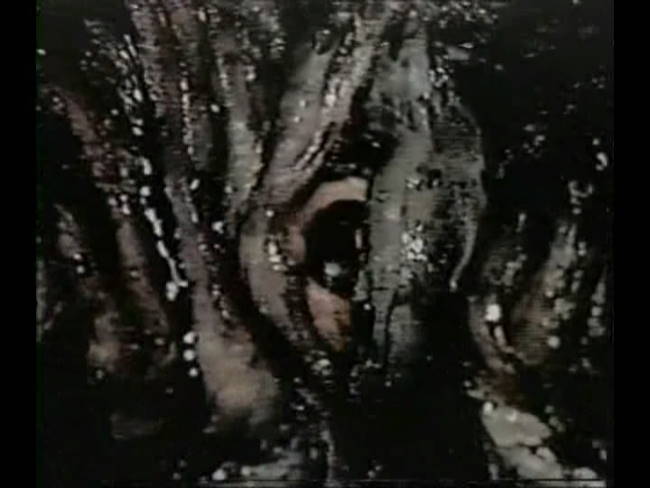
Life without flesh is death.
The Visuals: Like many experimental films, Izumiya literally throws in every kind of camera technique available. We get tons of perspective shots, multiple exposure shots, different overexposed lighting shots, completely strange camera angles (like a sideways up-above running shot), all wrapped up in a myriad of disturbing visuals. Whether we get coherency or not, Death Powder is certainly creative. I really wish I had been able to obtain a better copy of the film, as I’m afraid the color is washed out on Lostsilver’s public domain version (although I don’t know – perhaps this is intentional). This leaves the film with a very washed out, almost (but not quite) black and white look.
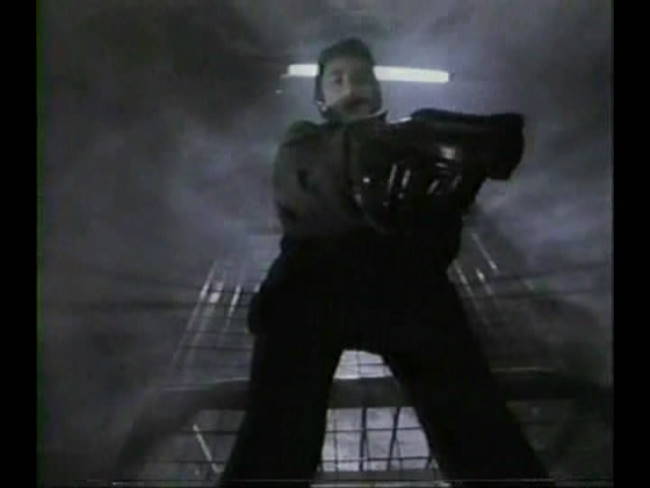
The Sound: Perhaps Death Powder’s best strength is in its sound effects. Izumiya continually barrages the audience with a cornucopia of industrial/techno cyberpunk sounds. We get various low-toned keyboard pieces combined with strange and eerie sounds of all types and textures. If I had to guess, I’d say the majority of the time spent on producing Death Powder was working with the sound track – it’s by far the most polished aspect of the movie. This may not be all that surprising considering Izumiya got his start composing for Japanese Cyberpunk director Sogo Ishii on Crazy Thunder Road.
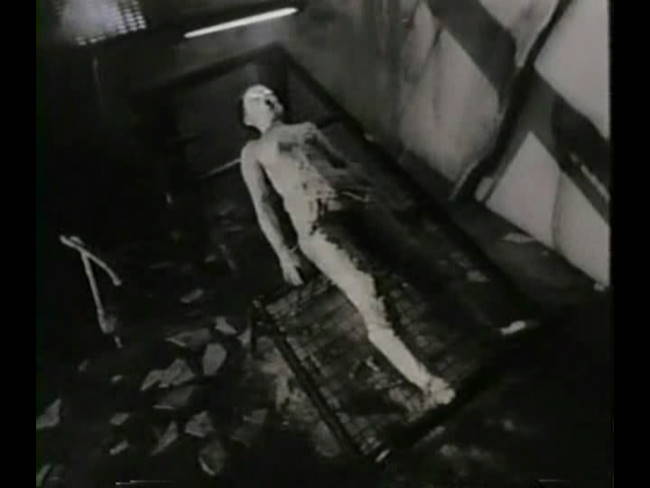
The Bottom Line: I wonder if I’ve become jaded since watching a number of these extreme Japanese Cyberpunk flicks. Many comments about Death Powder indicate that people were blown away by the visuals and have never seen anything like this – some to the point of even having nightmares about it. If this is your first, or perhaps even second experience in delving into extreme Japanese Cyberpunk movies, than perhaps Death Powder comes off much better. However, as much as I love the experimental visuals, this movie clearly could have been put together better. There is a lack of crafting in Death Powder which negatively impacts the movie-watching experience. Still, Death Powder, while incoherent, is at least unique, creative and interesting, so there’s certainly something worth watching here. It’s for this reason that I’m giving it 5 stars instead of 4. I really wish I was able to get a better transfer of this, but even if I had it, I still doubt I’d be giving it more than 5 stars.
~See movies similar to this one~
Movie Review By: SFAM
Year: 1997
Directed by: Takashi Miike
Written by: Itaru Era (screenplay), Hiroki Yamaguchi (story)
IMDB Reference
Degree of Cyberpunk Visuals: Medium
Correlation to Cyberpunk Themes: Low
Key Cast Members:
Kensuke Hagane: Tsuyoshi Ujiki
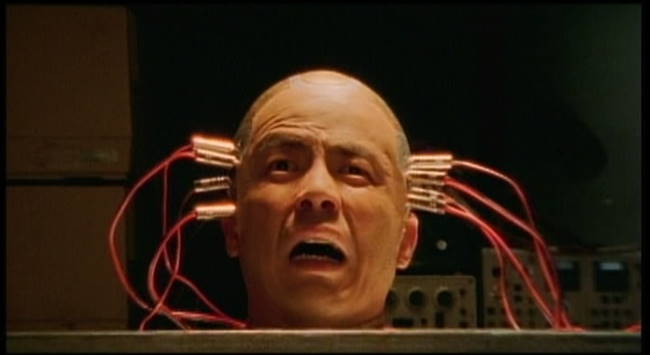
Overview: Full Metal Yakuza is simultaneously a campy low-budget Robocop Rip-off done with gangsters and an exercise in a mild form of extreme Japanese cinema. Director Takeshi Mike (best known for Ichi the Killer, but also did Andoromedia) does his trademark extreme blood spatters, and includes lots of head chopping, gun fighting, and a torture-rape-suicide scene thrown in for good measure. You won’t get any big picture thoughts out of this flick, but you might want to tune in for the crazy action and visuals.

The Story: Kensuke Hagane (Tsuyoshi Ujiki) is a slacker junior gangster who doesn’t show a lot of potential. In his mind, he wants to be a Yakuza – a tough guy with a code that’s feared by all. Unfortunately, he just doesn’t have what it takes. He sucks at fighting, enforcement, and worse – he even sucks at love making. He idolizes the older Tousa, a gangster tough guy extraordinaire that has a detailed dragon tattooed on his back. After Tousa gets taken prisoner for 7 years, Hagane perseveres to become an enforcer. Unfortunately, when released, the Yakuza gang betrays Tousa and shoots him down – Kensuke gets killed in the crossfire.
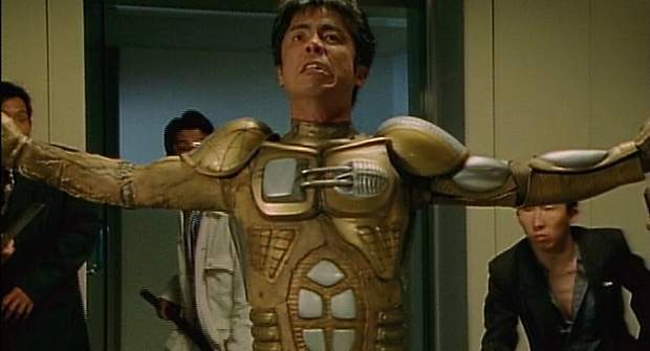
Then the weirdness begins – Hagane wakes up in a strange lab, and finds out that his head has been removed from his body and is now attached to a cyborg body, partially made up with Tousa’s remains. He has Tousa’s heart, hands, feet, tattooed back, and most importantly, his very large “member.” An insane genius scientist ((TETSUO’s Tomorowo Taguchi), for reasons never explained, has brought him back to life, but before Hagane agrees to work with the scientist, he must take revenge on those who killed him and Tousa.

Hagane goes all out, killing his way to the top, but eventually stops due to the pleading of his former friend. Along the way, he also finds Tousa’s mistress (Shoko Nakahara), and falls in love with her. Things go horribly wrong when she is taken prisoner. Hagane now has to finish what he started.
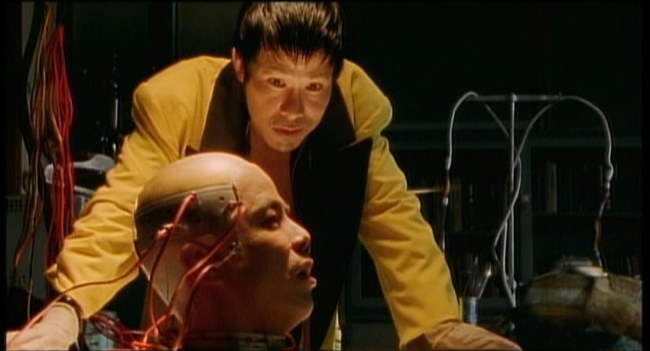
Yes, He’s a Cyborg, But…: Nothing in this movie should be taken too seriously, especially the cyborg aspects of this. Kensuke eats bullets and other assorted metals for energy, but apparently doesn’t even need to grind his teeth to chew them. His body is fully metal, but apparently he’s had an extra large dick grafted on as well. He does weird chants in order to temporarily turn off his emotions (apparently, this trips a jump switch of some kind). I could go on, but nothing in this depiction of cyborgs is intended to be anything other than the creation of a setting.
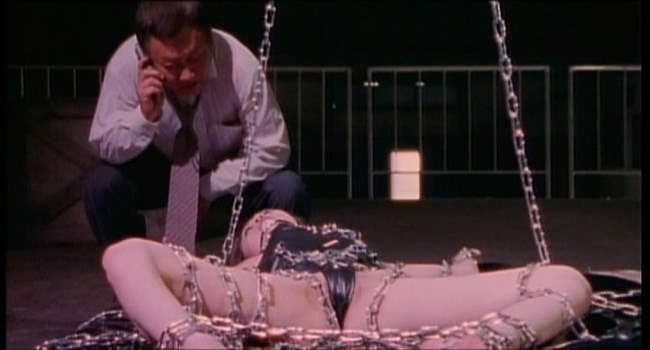
The Visuals: Full Metal Yakuza gives us a number of trademark Takeshi Mike shots, including massive screaming, gratuitous blood spurts shooting in all directions, torture and rape, and a variety of surreal action scenes. From a cyberpunk standpoint, the interesting visuals take place when Hagane is first transformed into a cyborg. In many ways, they resemble a lighter version of Android from Notre Dame’s visuals.
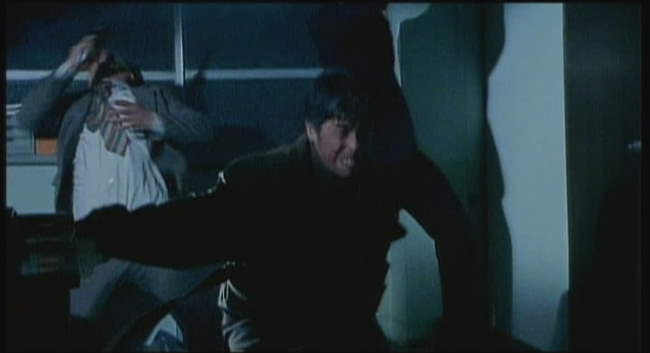
The Bottom Line: Full Metal Yakuza is interesting in that it was apparently made for a very low budget. There is enough here in terms of strange, extreme cyberpunk visuals that many might really enjoy this flick. Just don’t be expecting too much from the story. There are whole sets of scenes that go absolutely no where (the female cyborg chick, for instance), and many more that strain the bounds of coherence. But if you’re interested in watching a campy, extreme Japanese, non-sensical cyberpunk flick, you might want to give Full Metal Yakuza a try.
~See movies similar to this one~
Movie Review By: SFAM
Year: 1993
Directed by: Fred Dekker
Written by: Frank Miller & Fred Dekker
IMDB Reference
Degree of Cyberpunk Visuals: Medium
Correlation to Cyberpunk Themes: Low
Key Cast Members:
RoboCop: Robert John Burke
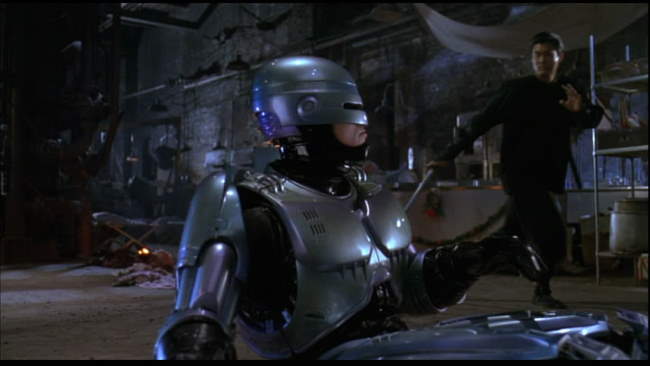
Overview: The first Robocop movie was an absolutely terrific, innovative flick. Robocop 2 really sucked, but not as bad as Robocop 3. All pretense of putting together a decent movie goes away in Robocop 3. Peter Weller, who plays Robocop in the first two movies wisely skipped this piece of shit. The only remaining cast members from the first are the Police Captain, Officer Lewis (Nancy Allen), the stooge corporate dude, Johnson (Felton Perry). Of these, only Officer Lewis had any chance of carrying a decent amount of heft for the show, but she is prematurely bumped off without reason, and the other two are pretty much just caricatures of themselves. In short, Robocop 3 is a pure, low-budget trashy sellout made for 8-14 year-olds who were familiar with the G-rated series - the plot goes for the young genius hacker kid and ninja bad guy vice attempting to work up a real plot.
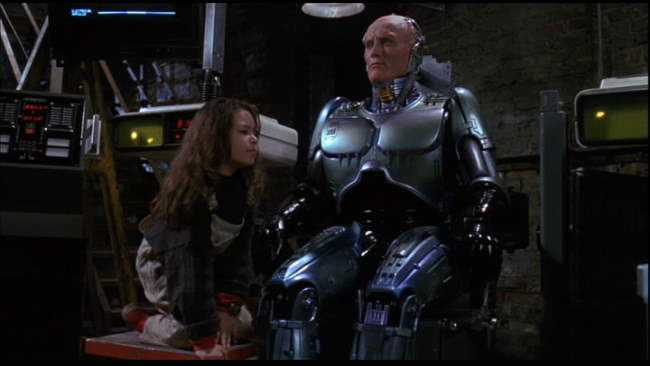
The Story: Like Robocop 2, OCP is still trying to create a massively expensive city in a place that only has the destitute poor. God knows why, as nobody will be able to afford ANYTHING created, but we’re just supposed to go with it. In this episode, we have the nasty Japanese buying up OCP and hiring a cheesy security firm to simply gather up all the poor people and ship them out to concentration camps. But Robocop doesn’t like this, and decides he no longer feels like obeying his prime directive that stops him from challenging OCP employees. Instead, he joins a ragtag resistance comprised of local yokels, the genius kid, and of course his sympathetic OCP scientist care taker. But wait! There’s more! The evil Japanese have sent a cyborg ninja to kill Robocop. Ohhhhhhh – you can just cut the tension with a plastic spoon!
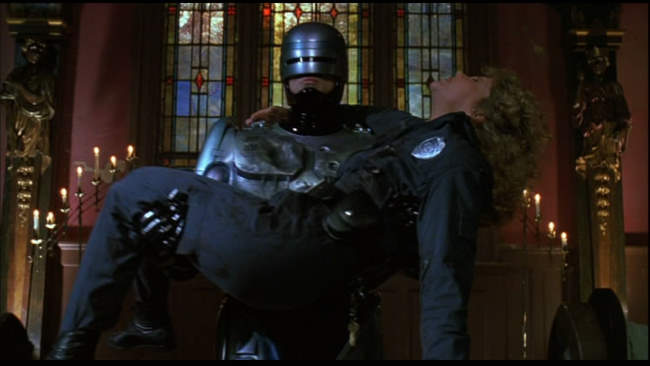
The Bottom Line: Honestly, I have a hard time seeing how Frank Miller is in any way responsible for the screenplay for this piece of trash. It’s pretty sad to see the Robocop movies end in such a trashy way. Yes, there is another kiddie miniseries that follows this, but truly, Robocop should have stopped after the first. This franchise is the poster child for Hollywood fuckups. In thinking about it, they could have done quite a lot with the Robocop universe, and potentially even could have done interesting things with the original Robocop character. Instead, they choose the cheesy derivative path. This led to both less money and the painful death of the cash cow.
~See movies similar to this one~
Movie Review By: SFAM
Year: 1996
Directed by: Jon Kroll
Written by: Mark Valenti
IMDB Reference
Degree of Cyberpunk Visuals: Low
Correlation to Cyberpunk Themes: Medium
Key Cast Members:
Menno: Bill Campbell
Loria: Stephanie Romanov
Mick Dourif, Rebel Leader: Bruce Campbell
Simon, Menno’s Friend: Michael Dorn
Felix Medina: Corbin Bernsen
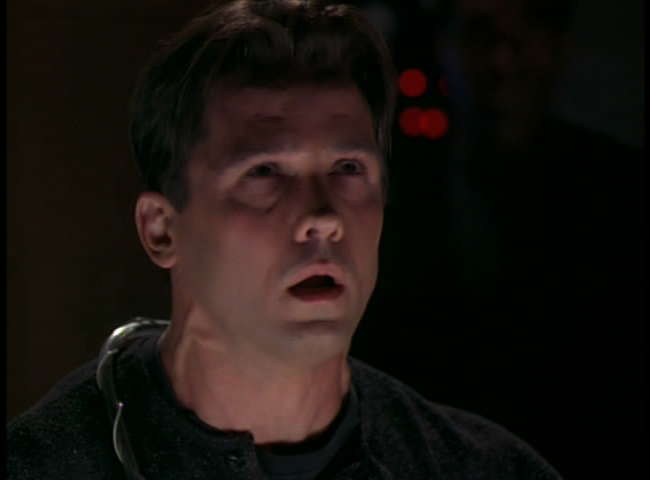
Overview: Here we have a movie with Bruce Campbell, Michael Dorn, and the very hawt Stephanie Romonov – this movie’s got to have something appealing, right? Um, not really. Menno’s Mind, a Showtime production is nowhere close to ready for prime time. The only thing worse than the acting and effects is the completely incoherent story. The FX are crappy low budget ones, but truly, nothing else in the movie even comes close to equaling them.
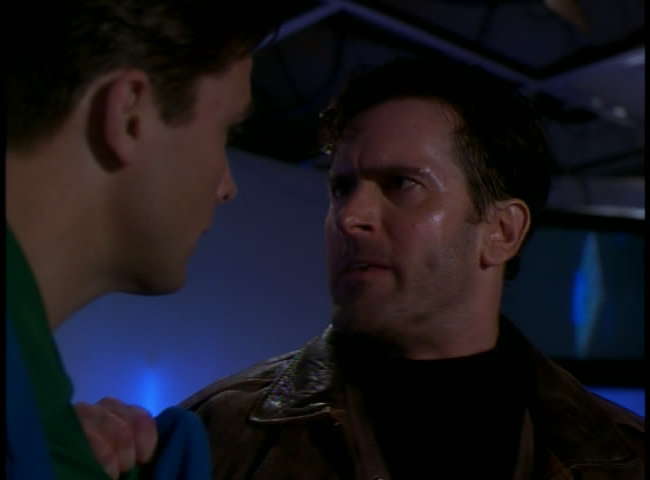
The Story: Menno’s mind takes place in a bizarre, cheesy future where everyone dresses in tacky bright clothes, except for the tough chicks, who wear black leather. Menno (The Rocketeer’s Bill Campbell) is a sappy computer programmer at a very popular virtual reality resort that provides people a choice of interesting vacations (most choose the virtual sex chick on the beach). The “System” that runs the VR vacations is very powerful, and has the capability to implant thoughts and suggestions into the vacationers. The resort’s head of security, Felix Medina (Corbin Bernsen), also happens to be running for President of the US (I shit you not…how far that office must have fallen for a head of security of a resort to be in the running!), and has decided to game the election by getting everyone who takes a vacation to be implanted with thoughts to vote for him in the election.
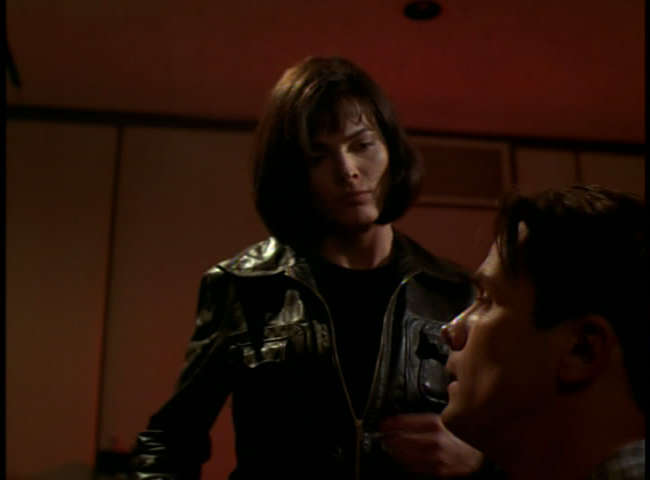
Luckily, disgruntled employee and rebel leader, Mick Dourif (Bruce Campbell), figures out the dastardly ploy and tries to stop it. Unfortunately, the bad guys have found him, and ambush his hideout. He barely escapes, goes to the VR resort, and forces Menno to upload his mind into the VR system before he dies! Yep, you heard it right, ladies and gents – although it wasn’t in the specs, apparently the VR system has the ability upload a human mind. Then things get interesting when Mick’s girlfriend, Loria, finds Menno and forces him to download Mick’s mind into himself in order to find out what Mick knew about the dastardly plot! From there, the race is on.
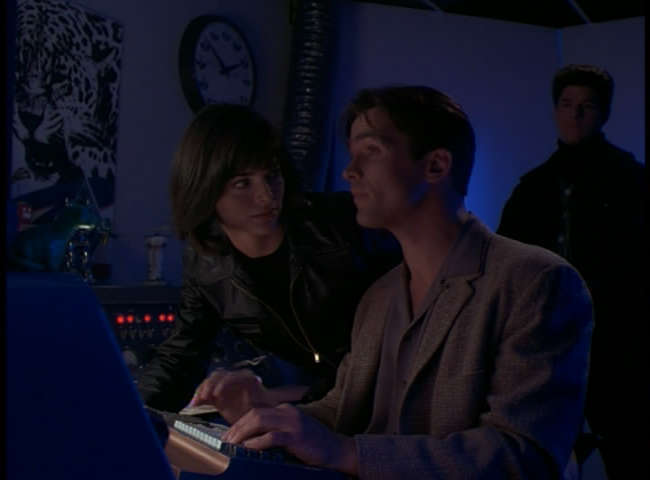
The Bottom Line: Truly, the number of problems and plot holes in this are almost uncountable. I’ll give it three stars because the production values are at least decent, but the story sucks more than words can describe. OK, so a security manager is running for President of the US – perhaps he should consider campaigning instead of trying to game a few hundred votes by convincing those who show up in the morning to vote for him – just a thought! I could go on, but the fairy science shown in this doesn’t even try to hold itself together. Worse, Bruce Campbell – really, the only reason I wanted to see this (I LOVE Army of Darkness!!!), dies early enough on that you barely get a chance to enjoy him.
~See movies similar to this one~
|






































































